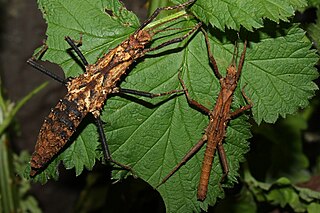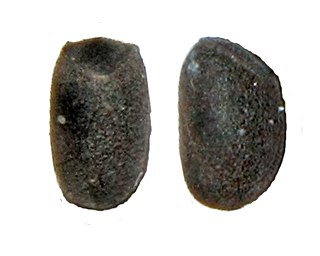
The Heteropterygidae is a family of stick insects belonging to the suborder Euphasmatodea. Species can be found in Australasia, East and Southeast Asia. About 150 valid species have been described.

The Obriminae are the most species-rich subfamily of the Phasmatodea family Heteropterygidae native to Southeast Asia. It is divided into two tribe.

Hoploclonia is the only genus of the tribe Hoplocloniini and brings together relatively small and darkly coloured Phasmatodea species.

The genus Tisamenus native to the Philippines combines small to medium-sized species of stick insects.

Eubulides is a stick insect genus native to the Philippines.

Tisamenus serratorius is a stick insect species that occurs on the Philippine island Luzon.

Tisamenus deplanatus is a stick insect species native to the Philippine islands Luzon and Mindanao occurs.

Tisamenus fratercula is a stick insect species native to the Philippine island Luzon.

Heterocopus is a monotypic stick insect genus, containing Heterocopus leprosus as the only valid species.

Stenobrimus is a genus of medium-sized stick insects native to the Philippines.
Pterobrimus is a monotypic genus of stick insects (Phasmatodea), containing the species Pterobrimus depressus, which is native to Fiji.

Tisamenus draconinus is a species of stick insect in the family Heteropterygidae native to the Philippines.

Tisamenus ranarius is a stick insect species (Phasmatodea), in the family of the Heteropterygidae native to the Philippines.

Tisamenus hebardi is a stick insect species (Phasmatodea), in the family of the Heteropterygidae endemic to the north of the Philippine island of Luzon.

Tisamenus armadillo is a stick insect species (Phasmatodea) in the family Heteropterygidae, endemic to the Philippines.

Tisamenus hystrix is a stick insect species (Phasmatodea), in the family of the Heteropterygidae endemic to the Philippines.

Tisamenus lachesis is a stick insect species (Phasmatodea), in the family of the Heteropterygidae endemic to the Philippine Polillo Island.
Tisamenus cervicornis is a stick insect species (Phasmatodea), in the family of the Heteropterygidae endemic to the Philippine island Luzon in the province of Camarines Sur.
Tisamenus asper is a stick insect species (Phasmatodea), in the family of the Heteropterygidae endemic to the Philippine island Luzon.

Eubulides igorrote is a stick insect species from the family of the Heteropterygidae native to the Philippine island of Luzon.





















